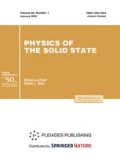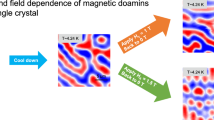Abstract
A dislocation glide mechanism at low temperatures is proposed. The mechanism is based on the inclusion of dynamic atomic displacements, i.e., those caused by nonadiabatic transitions of atoms in a crystal with a dislocation under action of an external force. The dynamic displacements initiate the instability of a rectilinear dislocation with respect to low-amplitude displacements during atomic vibrations. The instability development leads to the formation of a double kink and the dislocation displacement by one interatomic distance.



Similar content being viewed by others
REFERENCES
R. E. Peierls, Proc. Phys. Soc. London 52, 34 (1940).
L. Proville, D. Rodney, and M.-C. Marinica, Nat. Mater. 11, 845 (2012).
S. Narayanan, D. L. McDowell, and T. Zhu, J. Mech. Phys. Solids 65, 54 (2014).
C. Domain and G. Monnet, Phys. Rev. Lett. 95, 215506 (2005).
T. H. Blewitt, J. R. Redman, T. A. Sherill, and R. R. Coltman, Phys. Rev. 98, 1555 (1955).
E. T. Wessel, Trans. ASM 49, 149 (1957).
Z. S. Basinski and A. Sleeswyk, Acta Met. 5, 176 (1957).
P. Haasen, Philos. Mag. 3, 384 (1958).
B. V. Petukhov and V. L. Pokrovskii, Sov. Phys. JETP 36, 336 (1973).
R. Kapral, J. Phys.: Condens. Matter 27, 073201 (2015).
L. Landau, Phys. Z. Sow. 2, 46 (1932).
C. Zener, Proc. R. Soc. A 137, 696 (1932).
V. E. Egorushkin and N. V. Mel’nikova, J. Exp. Theor. Phys. 76, 103 (1993).
M. C. Cross and P. C. Hohenberg, Rev. Mod. Phys. 65, 854 (1993).
I. S. Aranson, Rev. Mod. Phys. 74, 99 (2002).
ACKNOWLEDGMENTS
The authors are grateful to L.B. Zuev, P.P. Kaminskii, and E.E. Slyadnikov for their interest in our work and useful remarks.
Funding
The work was performed under the government statement of work for ISPMS Project No. III.23.1.2.
Author information
Authors and Affiliations
Corresponding author
Ethics declarations
The authors declare that they have no conflicts of interest.
Additional information
Translated by Yu. Ryzhkov
APPENDIX
APPENDIX
The numerical solution of Eqs. (3), (4), and (6)–(8) was performed by an implicit scheme. We introduced dimensionless variables
The boundary conditions:
The initial conditions
The localized perturbations were given in the form
where Δη0 and Δq0 are the amplitudes, x0 is the initial position, ση, σq are the dispersions of the perturbations of variables η and q, respectively.
The stochastic perturbation Δq in each site of the calculation mesh was taken a random value in the range
Rights and permissions
About this article
Cite this article
Khon, Y.A., Zapolsky, H. Dynamic Atomic Displacements and Athermal Dislocation Glide in Crystals. Phys. Solid State 62, 587–591 (2020). https://doi.org/10.1134/S1063783420040137
Received:
Revised:
Accepted:
Published:
Issue Date:
DOI: https://doi.org/10.1134/S1063783420040137




